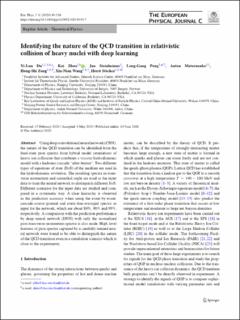| dc.contributor.author | Du, Yilun | |
| dc.contributor.author | Zhou, Kai | |
| dc.contributor.author | Steinheimer, Jan | |
| dc.contributor.author | Pang, Long-Gang | |
| dc.contributor.author | Motornenko, Anton | |
| dc.contributor.author | Zong, Hong-Shi | |
| dc.contributor.author | Wang, Xin-Nian | |
| dc.contributor.author | Stöcker, Horst | |
| dc.date.accessioned | 2021-06-30T12:37:28Z | |
| dc.date.available | 2021-06-30T12:37:28Z | |
| dc.date.created | 2021-02-25T12:12:58Z | |
| dc.date.issued | 2020 | |
| dc.identifier.issn | 1434-6044 | |
| dc.identifier.uri | https://hdl.handle.net/11250/2762590 | |
| dc.description.abstract | Using deep convolutional neural network (CNN), the nature of the QCD transition can be identified from the final-state pion spectra from hybrid model simulations of heavy-ion collisions that combines a viscous hydrodynamic model with a hadronic cascade “after-burner”. Two different types of equations of state (EoS) of the medium are used in the hydrodynamic evolution. The resulting spectra in transverse momentum and azimuthal angle are used as the input data to train the neural network to distinguish different EoS. Different scenarios for the input data are studied and compared in a systematic way. A clear hierarchy is observed in the prediction accuracy when using the event-by-event, cascade-coarse-grained and event-fine-averaged spectra as input for the network, which are about 80%, 90% and 99%, respectively. A comparison with the prediction performance by deep neural network (DNN) with only the normalized pion transverse momentum spectra is also made. High-level features of pion spectra captured by a carefully-trained neural network were found to be able to distinguish the nature of the QCD transition even in a simulation scenario which is close to the experiments. | en_US |
| dc.language.iso | eng | en_US |
| dc.publisher | Springer | en_US |
| dc.rights | Navngivelse 4.0 Internasjonal | * |
| dc.rights.uri | http://creativecommons.org/licenses/by/4.0/deed.no | * |
| dc.title | Identifying the nature of the QCD transition in relativistic collision of heavy nuclei with deep learning | en_US |
| dc.type | Journal article | en_US |
| dc.type | Peer reviewed | en_US |
| dc.description.version | publishedVersion | en_US |
| dc.rights.holder | Copyright 2020 The Author(s). | en_US |
| dc.source.articlenumber | 516 | en_US |
| cristin.ispublished | true | |
| cristin.fulltext | original | |
| cristin.qualitycode | 2 | |
| dc.identifier.doi | 10.1140/epjc/s10052-020-8030-7 | |
| dc.identifier.cristin | 1893645 | |
| dc.source.journal | European Physical Journal C | en_US |
| dc.identifier.citation | European Physical Journal C. 2020, 80, 516 | en_US |
| dc.source.volume | 80 | en_US |

